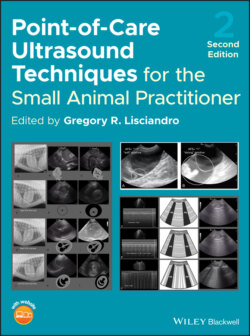Читать книгу Point-of-Care Ultrasound Techniques for the Small Animal Practitioner - Группа авторов - Страница 240
Use for Cardiac Tamponade
ОглавлениеThe noncardiologist sonographer will grapple with this clinical question that often causes marked degrees of anxiety – does my patient have cardiac tamponade? And, taking it a step further – does my patient need emergent pericardiocentesis?
The diagnosis of cardiac tamponade is discussed in more detail in Chapters 18 and 21. Most importantly for the AFAST chapter, there exists a nonecho option, the characterization of the patient's CVC (see Figure 7.12)! Think about why and when an emergent pericardiocentesis would be indicated, and the answer – the presence of obstructive shock from PCE. By definition, obstructive shock from PCE results in a “FAT,” distended, with little respirophasic diametric CVC change. Thus, if the CVC is not “FAT” or distended and has a diametric respirophasic “bounce” to it, then your patient does not have cardiac tamponade. Moroever, if your patient is weak and collapsed, you need to investigate for other causes (using Global FAST). If your patient does have CVC characteristics suggestive of cardiac tamponade, look at your patient! If they are alert and in no distress, take a few breaths and relax, you have time on your side, the procedure may be delayed, complete echocardiography may be scheduled, and the procedure, if indicated, performed electively. However, if your patient is weak and unstable, an emergent life‐saving pericardiocentesis is indicated.
Figure 7.13. The racetrack sign of PCE with integration of the CVC characterization. (A,B) Inverted lateral thoracic radiographs to illustrate the anatomy in the ultrasound images in (C) and (D) with PCE evidenced by the rounding of anechoic fluid, referred to as the “racetrack sign” (Lisciandro 2014a,b, 2016a). Characterization of the CVC is helpful for evidence that obstructive shock and tamponade may be present. In (A) the CVC is unremarkable and in (B) the CVC is “FAT” and has associated hepatic venous distension supporting obstruction of blood flow to the right atrium. In (C) there is a small‐volume ascites (circled) and if a modified transudate, supports a more chronic case of PCE and a better prognosis. In (B) gallbladder wall edema, the “cardiac gallbladder,” is shown which is only expected with hepatic venous congestion and more chronicity to the PCE.
Source: Reproduced with permission of Dr Gregory Lisciandro, Hill Country Veterinary Specialists and FASTVet.com, Spicewood, TX.
Interestingly, the use of IVC distension (a “FAT” IVC) in people is only about 40% specific for the presence of cardiac tamponade. Conversely, a nondistended IVC at the subxiphoid view that has its expected normal variation in diameter in spontaneously breathing people effectively rules out cardiac tamponade with a sensitivity of 97% (Candotti and Arntfield 2015; Tchernodrinski and Arntfield 2015). The CVC in small animals likely proves similarly helpful with indirect nonechocardiographic (fallback view) information regarding the presence of obstructive shock from cardiac tamponade. We like the saying “Don't risk your patient's life trying for an echo view” – use the Global FAST fallback views (see Figure 36.7).
Figure 7.14. Relative positioning of gallbladder to diaphragm to caudal vena cava. (A,B) Line drawing overlays of the gallbladder (GB) and caudal vena cava (CVC). In (A) the heart is faintly visible on the still image analogous to the overlay in (B). In real time the beating heart is readily apparent. (B) Orientation of the heart as it lies against the diaphragm in both dogs and cats. LA, left atrium; LV, left ventricle; RA, right atrium; RV, right ventricle. The orientation and proportionality in the longitudinal plane are nearly identical independent of standing/sternal versus right lateral recumbency.
Source: Reproduced with permission of Dr Gregory Lisciandro, Hill Country Veterinary Specialists and FASTVet.com, Spicewood, TX.
Pearl: Always look cranial to the diaphragm because most cases of clinically relevant pericardial effusion are detected via the DH view, which is part of AFAST, TFAST, and Vet BLUE.
Pearl: Ascites (modified transudate) in cases of PCE cases carries a better prognosis because the PCE has been a more chronic process in that patient (Johnson et al. 2004). Always stage with Global FAST and encourage pericardiocentesis when indicated in these cases.
Pearl: The nonecho option for the presence or absence of cardiac tamponade is characterization of the CVC. A “bounce” to the CVC rules out tamponade versus a “FAT” distended CVC which supports the presence of obstructive shock and cardiac tamponade and the need for emergent pericardiocentesis in weak, collapsed patients, although it's best to look at the patient to make that final decision (stable, can wait; unstable, needs emergent pericardiocentesis).
